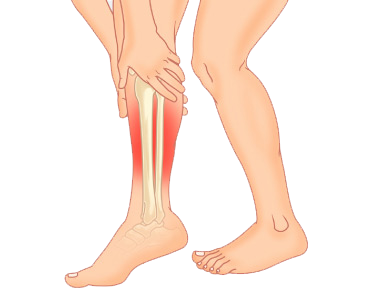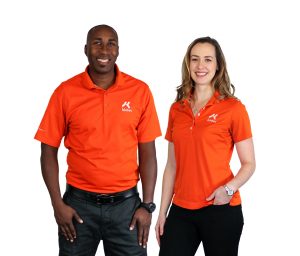Have a Doctor’s Referral?Book now

Shin Splints or Shin Pain can generally be described as pain at the front of the lower leg. The most common cause for the pain is inflammation of the periosteum of the tibia (sheath surrounding the bone).
If shin pain persists for greater than 4 weeks, and increases in severity, we recommend getting your doctor to take a look. More serious conditions, such as tibial stress reaction/fracture or anterior compartment syndrome, might be the underlying cause that require greater medical oversight.
You will see a certified pedorthist who specializes in foot mechanics,
conditions, and conservative treatments.
This condition is usually an overuse or overtraining injury. This can be from either increasing the amount of activity you have been doing, increasing intensity of the training, or increase the frequency of the activity. It is very common to runners, especially when hills are involved. Other factors can lead to shin splints:
Foot Mechanics: Flatter feet that tend to overpronate, or roll inward, place more strain on adjoining muscles, while high arched feet may be very rigid and unable to absorb impact forces easily.
Muscular Factors: Inflexible and tight calf muscles add extra strain on the shins.
Activities: Although the forces involved in running cause it to be a popular source of shin splints, any high impact activity can lead to this condition.
Individual: Running style, such as running on your tip-toes or flat footed, can increase your chances of developing shin splints.
Footwear: Wearing old worn out shoes, shoes without good cushioning, or shoes with the wrong design for your foot mechanics make you more susceptible to shin splints.
Rest: Use pain as a guide, and add cross-training activities, such as swimming or cycling to give shins a chance to rest while still maintaining your cardiovascular fitness.
Stretching and strengthening calf muscles: Consider starting a weight training program, and stretching daily, especially after activity.
Ice: In the early stages, apply ice if very painful to area for 15-20 min allowing at least 45 min for the area to warm before icing again. Icing is most effective up to 48 hrs following an injury. Never ice before activity.
Heat: Apply heat for 15—20 min after the initial acute period (after 48 hrs), especially before training.
Orthotics: If inflammation and pain is caused by overpronation, custom made orthotics or arch supports can help correct your foot mechanics. Orthotics can also help increase shock absorption for high arched rigid feet. At Kintec, we have a variety of custom orthotics created for your specific biomechanical and activity needs.
Footwear: Making sure you are in well cushioned shoes, or adding a cushioned insole, will help absorb impact forces.
Taping: Some sports taping methods are helpful for taking pressure off the shins.
Sports massage and/or Physio: These methods can reduce recovery time, talk to your doctor before starting any rehabilitation program.
Anti-inflammatory drugs: Combined with rest and ice, these can reduce inflammation but underlying causes (such as muscle tightness or foot mechanics) should be addressed to eliminate a reoccurrence. Consult with your doctor before taking any medication.
For more reading on plantar fasciitis, read more from Kintec:
